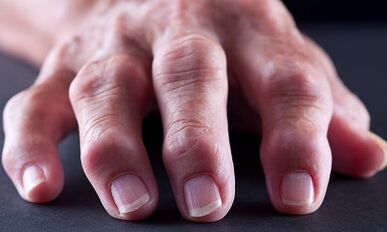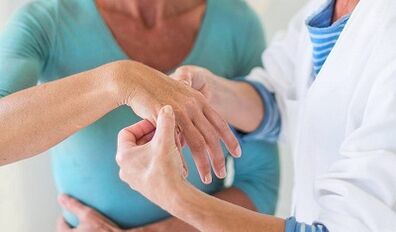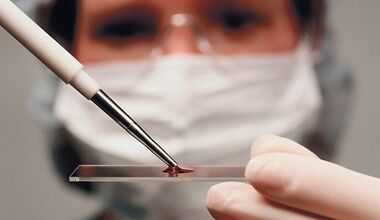Arthrosis and arthritis are a disease in which the joints are affected.Because the names of these diseases are consonants, many people have thinking about their identity.They see this term as synonymous, indicating that this is the same disease.However, arthrosis and arthritis are far from the same, and there are significant differences between them.To understand how different arthrosis is, let's find out what the disease is.
What is arthritis?
Arthritis is a collective term that means inflammation of the joints and most often shows a wider and serious pathological disorder in the body.That is, the disease is inflammation and can attract both joints and several joints.
There are several diseases accompanied by the development of arthritis:
- Rheumatism;
- gout;
- rheumatoid arthritis;
- systemic lupus erythematosus;
- psoriasis;
- Hemhramatosis.
In addition, there is a reactive arthritis that develops as a result of complications after an infectious disease:
- common cold;
- syphilis;
- Gonorrhea;
- mycoplasmosis;
- Chlamydia.
All these diseases are released in separate groups.
The process of inflammation for arthritis affects mainly synovial shells, and synovial fluid, causes disease (synovitis).As a result, the amount of this fluid increases, which is interpreted by the swelling of the affected joints.The cartilage that covers the surface of the bone is also inflamed, and over time the erosion states that the bone is formed on it.
What is arthrosis?

Arthrosis is a nonstrophic disease, which is associated with deformation and destruction of cartilage tissue in the joints.That is, pathological changes occur, indicated by cartilage dysfunction that coats the surface of the bone.Although sometimes it is a long inflammatory process that causes thinning and damage to the cartilage.Arthrosis is often observed in the elderly, as they wear cartilage with age, as well as osteoporosis, which negatively affects the overall state of support and motor tools.
In some cases, arthrosis can occur at a young age in people with long loads in the joints.This category includes athletes, people suffering from obesity or people whose professional activities lead to rapid use of support and motor systems.
Symptoms of the disease are caused by a violation of cartilage function, as it is depleted and defective, bone tissue grows, leading to the inability of the full performance of depreciation and friction of the joints.As a result, the amount of synovial fluid is reduced, which should cover the articular surface.
General reasons for the development of arthrosis and arthritis
Because arthrosis and arthritis affect the joints, and in general, the entire support engine is a motor tool, the disease develops due to many factors.
Let's see the ten causes of the disease:
- descent factors;
- metabolic violations;
- immune factors (especially for arthritis);
- congenital disease of connective tissue and bone;
- joint injury;
- overweight, obesity;
- excessive physical activity;
- Unbalanced diet;
- hypothermia;
- infection.
This is a common cause that can cause both arthritis and arthrosis.But this is the place where their equations are over.Further, the disease has only a difference.
Causes of Developmental Development of Arthritis and Arthrosis
Causes cause arthritis:

- Improper nutrition, which causes infringement of metabolic processes and immunity (poor nutrition causes the development of infectious diseases, and their agents penetrate synovial fluid and cause arthritis);
- strong hypothermia of the joints (spending the night in the tent, bathing in cold water, poor shoes -quality and clothing);
- any injury (stretch, bruised or broken);
- smoking and obesity;
- An inactive lifestyle.
Causes of arthrosis:
- descent factors;
- old age;
- injury;
- Metabolic disease.
Previously, the main one (when the cause of the disease was unknown) and secondary (when the cause was known) stage in the development of arthrosis.As the more advanced diagnostic method develops, the main stage is questioned, as in all cases the main cause of arthrosis development is metabolic disorders in the form of carbohydrate metabolism and ferrous enzymes.Therefore, arthrosis can occur as a result of arthritis, as synovial fluid dysfunction is no more than metabolic disorders.During the dystrophic process, the blood circulation of the joints is disrupted, leading to the deterioration of nutrition and the destruction of cartilage.
What is the difference between arthritis from arthrosis
Let's see how different arthrosis is.Because arthritis and arthrosis often affect the same joints, therefore, despite this, there are still several patterns in localization of the pathological process:
- Arthrosis often develops in the large joints of the lower leg (ankle, knee, hip).In addition, the pathological process develops only in one joint.Throughout life, all of these joints suffered a huge burden, so it was not surprising that they were wearing and destroying because of the destructive process.Rarely arthrosis affects the joints of the thumb, hands and intervertebral joints.
- With arthritis, the joints are affected one by one, that is, the disease is a "flying" characteristic.Let's say that the wrist joint is inflamed in one day, on the other hand - the elbow, in the third - the shoulder joint.In addition, some asymmetric joints can become inflamed at once.
In addition to localization of the pathological process features, there is a difference between arthritis and arthrosis in symptoms:
- With arthritis, pain occurs at night, when someone is resting.And in the morning, the patient feels the stiffness of the affected joints.To relieve the stiffness, they need to develop joints.Some patients interpret this phenomenon as a norm, forgetting that healthy people do not need shared development after sleep.Their joints are always mobile and functional.With arthrosis, such stiffness is not obeyed.
- In the case of arthrosis, everything happens the opposite.At rest, the patient is relieved, as pain occurs only when moving and becoming more intense with significant motor activity.Sometimes, with arthrosis, pain can also occur at night, but they are associated with the fact that the patient changes the position of the affected member in the dream, which causes pain.
- The appearance of joints with arthritis and arthrosis is also different.With arthritis, phalanx metacarpal joints (convex bones from compressed fists) swell and swell, squeeze and heat (local temperatures increase).With arthrosis, such symptoms are not observed, the joints look very normal.Of course, in the future, joint deformation may occur due to the growth of osteophytes (bone growth in the joints), but even in this case there are no symptoms of arthritis.But with arthrosis, the crisis is observed in the affected joints, which is not with arthritis.
It is important to note the general condition of the patient in the disease.With arthritis, a person, in addition to pain in the joints, experienced weakness, general disease disease: subfebrile temperature, chills, headache, loss of appetite, losing weight.With arthrosis, the problem is only in the joints that are not functional and painful, and the general symptoms are not complied with.
It should be noted that arthritis often leads to arthrosis, when the joints are destroyed and modified as a result of inflammation, and its mobility is also disrupted.However, with arthrosis, the inflammation process is observed in the joints.It is not easy to understand the diagnosis, you need to know the main cause of the disease.Arthritis, as a rule, occurs in the background of infection that enters the joint tissue, and in the case of arthrosis, joint deformation occurs as a result of injury, in old age.Of course, sometimes inflammation can be involved, but this is not always the case.
Diagnosis of differential arthrosis and arthritis
To find out what the problem is with the joints, it is necessary to carry out the differential diagnosis.This diagnosis includes the following clinical trials:
- General blood test.
- general urine analysis;
- biochemical blood tests;
- rheumatic tests;
- autoimmune norms (blood tests for antibodies);
- X -ray affected joints;
- synovial fluid examination;
- frame radioisotopic scanning (in some cases);
- Computed tomography (CT);
- Magnet - resonance tomography (CT or MRI).
Blood tests for arthritis and arthrosis
For adequate diagnosis of articular disease, this procedure is mandatory and necessary.In the case of arthrosis, the clinical picture of the blood does not change at all, it can only slightly increase the roe (erythrocyte solution) to 28-30 mm, usually with complications-minovitis.With arthritis, the blood image is completely changed: leukocytes rise to 14,000, the transition of leukocytes on the left is observed, reactive protein levels C - ROE and ROE to 40 - 80 mm increase.
C - jet in the blood

For differential diagnosis, biochemical blood tests must be performed.With arthritis, there is an increase in inflammation of some immunoglobulin, seromucoid and reactive protein, which is not observed with arthrosis.Exact factors diagnose the level of inflammation in articular disease is considered to be a C - reactive (CRB).Because synovial fluid reacts with increased protein to inflammation, with the inflammation and autoimmune process in the body, the level increases to 10 mg/l and higher.Compared to healthy people whose reactive protein does not exceed 0.002 g/l.Therefore, an increase in reactive protein levels in blood plasma fluently shows the development of arthritis.
C - reactive protein (CRB) is a quick phase protein that is synthesized in the liver.Activate the body's immune response to the invasion of inflammatory factors.After 24 hours, the level of reactive protein in the plasma increased ten times.With adequate treatment, protein decreases quickly to normal indicators.With arthrosis in the patient's blood, the reactive protein indicator remains normal.
X -ray affected joints
This diagnostic method is the second most effective after clinical blood tests.In this case, arthrosis is accurate, as the degree of bone deformation with the width of the joint gap can be determined on radiography.For arthritis, this method is not important, although it is certainly prescribed as a diagnostic technique.However, this method is not perfect, as the degree of damage and destruction of cartilage tissue cannot be seen in the picture.
Differences in the treatment of arthritis and arthrosis
Arthritis and arthrosis have different developmental causes and mechanisms, so their treatment is slightly different.
With arthritis, it is necessary to first identify the cause of the development of inflammation and neutralize it as soon as possible.In the event of arthritis has an infectious etiology, the patient is prescribed antibiotics.With the origin of the autoimmune of the disease, cytostatic and hormone is prescribed, and with gouty arthritis, the correction of uric acid in the body is necessary, therefore, treatment is performed by hypoweminating drugs.
With arthrosis, this treatment is intended to restore cartilage tissue and the return of joint function.Therefore, treatment is performed by chondroprotectors, hyaluronic acid, physiotherapy, sanitary treatment, massage and physiotherapy.

Since both arthritis and arthrosis are accompanied by clear pain syndrome, anti -anti -non -–steroid drugs for internal and external use (tablets and ointments) act as painkillers, with the disease.Such medications not only relieve pain effectively, but also reduce the signs of inflammation.
In the treatment of the disease, both conservative treatments and surgical therapy are used.It all depends on the level and scale of the articular lesion.As a rule, this is a drug and prosthetic treatment.
Given the fact that chronic arthritis and arthrosis increase the likelihood of acute relapse, therapeutic strategies should be aimed at preventing and preventing relapse.The following treatment is prescribed for this:
- The use of anti -non -ssteroid drugs (NSAIDs).Medications of these groups effectively eliminate the signs of inflammation, especially with arthritis, but are always included in the therapeutic complex and with arthrosis.
- Rapid removal of muscle spasms that occur in the muscles adjacent to the joints.Therefore, access to drugs, nutrients and oxygen is provided.
- Normalization of metabolic reactions.This may only be after stopping the inflammation process.
- Transfer from uric acid salt joints (if we talk about infringement of metabolic processes).
- Acid normalization - alkaline metabolism.
Modern medicine has successfully treated arthritis and arthrosis, but in this case, not every case of arthritis or arthrosis ends with complete success.
Success in the treatment of the disease is to relieve inflammation of the joints and muscles, in the normalization of metabolic processes and acid balance.As a result of this action, the joints begin to receive full nutrition, oxygen and restore metabolic processes.
Traditional medicine recipes are very effective in the treatment of complex arthritis and arthrosis.Their use in this format is approved even by official drugs.It should be immediately stated that medicinal herbs are only an additional remedy in the fight against the disease.Therefore, before proceeding with the people's remedies, you should without fail to get a recommendation to the attending physician.
Eat for arthritis and arthrosis
All joints, without exception, require special dietary diet.Because the symptoms of arthritis affect the entire organism, in some cases, the journey is complicated by serious disorders in cardiac work, kidneys and liver, and arthrosis can disrupt the patient, lead to defects and thus reduce the quality of life, it is necessary to remove all power to fight the disease.

In the context of articular pathology, the body should accept all the nutrients, vitamins and minerals needed with certain tendencies.Normalizing metabolic reactions and acid balance -are considered to the product.
General nutrition suggestions can be as follows:
- Limit the use of red meat (pork, beef, goat, deer, horse);
- rejection of products containing large amounts of fat and trans fat;
- complete refusal of alcohol;
- giving priority to low fish and seafood;
- take a large number of vegetables, fruits and herbs (in any form);
- The use of cartilage based dishes: floods, jelly, jelly, marmalade;
- Drinking regime;
- Take supplements with calcium, vitamins A, D and Group V.
General prevention of arthritis and arthrosis
In the treatment of arthritis and arthrosis, the therapeutic strategy consists of preventing and preventing relapse of arthritis and arthrosis.After all, the disease is easier to warn than treat.Therefore, the prevention of the disease has the same principle:
- Avoid foot hypothermia (foot joints).After all, this road is a key factor in aggravating chronic diseases and infections with viral infections.
- Timely chronic diseases (tonsillitis, sinusitis, bronchitis).
- Uncomfortable shoe rejection.Unknown shoes create additional loads on the joints, leading to their destruction, deformation and tagging, and their consequences to arthrosis.
- The struggle against overweight.Excessive weight is a signal of metabolic disorders, and arthritis almost always occurs in the background of the violation.
- Moderate physical activity.Heavy work causes pressure and burden on the joints, as a result they are destroyed and inflamed.
- Be sure to adhere to a healthy lifestyle: often walking in the air, relaxing and eating, engaging in physiotherapy exercises, regularly visiting doctors.
Physical education for arthritis and arthrosis is a very important part of therapy in compartments with massage, dietary therapy and physiotherapy.It provides pain joints with nutrients and oxygen, and without their recovery and recovery they cannot occur.

















































